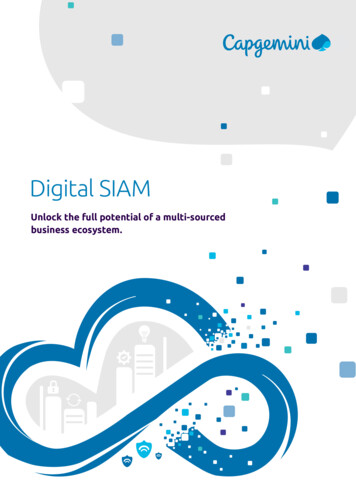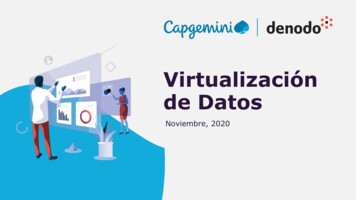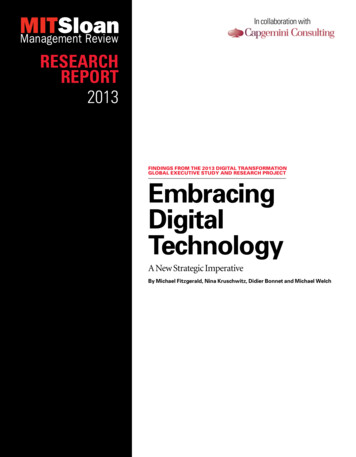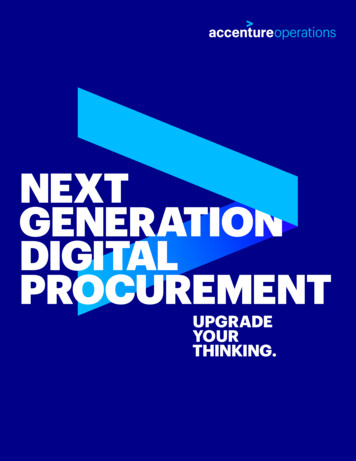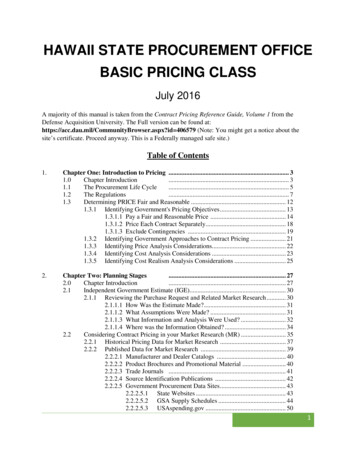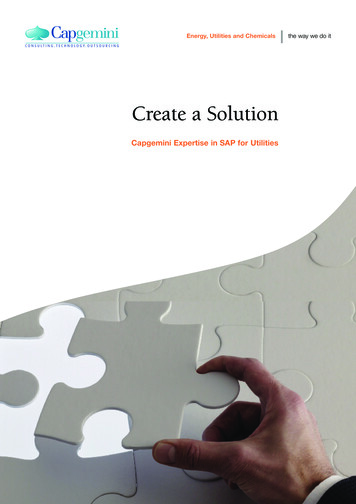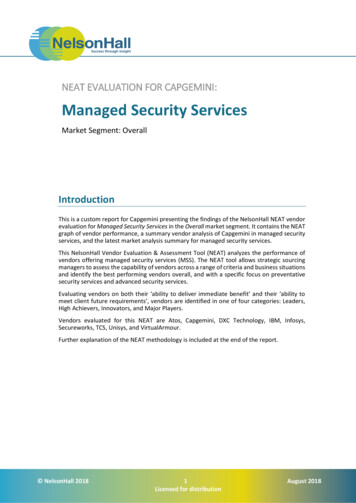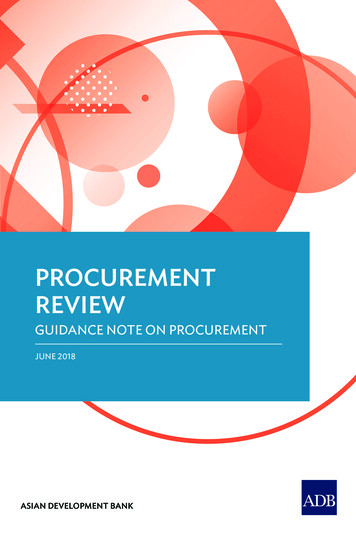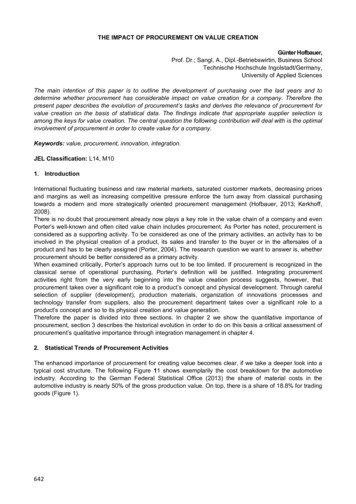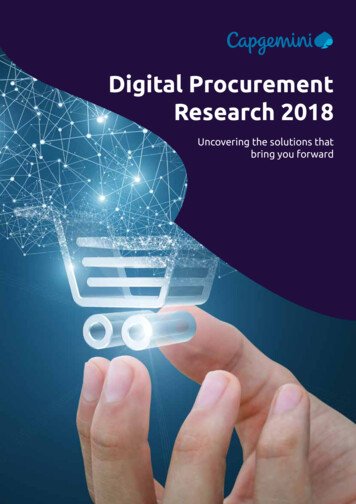
Transcription
Digital ProcurementResearch 2018Uncovering the solutions thatbring you forward
2Digital Procurement Research 2018.
ForewordChristian Michalak,Vice President,Head of ProcurementTransformation DACHThe world is digitizing rapidly and becoming increasinglyconnected. Widespread terms such as Internet of Thingsand Industry4.0 reflect this. Traditionally, the procurementdepartment falls behind in digital transformations, resulting ininefficiencies , unnecessary high costs and being perceived as anannoyance by the operational departments. But this situation ischanging.The traditional procurement function is evolving, and manypeople are afraid of this. They wonder about the future, whetherprocurement will still play a role, while they should be wonderingwhat opportunities it offers, for example in the context of digital,and how procurement can act on the next level.Procurement, and at the same time management and businessstakeholders, should move away from the traditional focus oncost reduction and rather focus on how to get more or, evenbetter, most value out of the relationship with their suppliers.This way procurement will shift to the core of the organization.Unfortunately, the courage to invest in and to execute aprocurement transformation often takes far too long, becauseattention regularly shifts to opportunities or challenges thatare regarded as more pressing. However, by transforming theprocurement function and providing the right skills, digitalenablers, purchasing systems and tools, pure cost managementbecomes a commodity. As a result, procurement can take upresponsibilities beyond their traditional scope. They can becomea change agent and transformation partner of the business,focusing on efficiency and innovation, turning themselves into avalue adding department.Xander de Jong,Senior Manager,Head of ProcurementTransformation NLCapgemini Digital ProcurementResearch 2018Cloud procurement solutions offer many exciting opportunitiesfor every business and in both direct and indirect procurement.However, since there are many players, it is a challenge todetermine which ones to shortlist or select.Therefore, we are proud to present the Capgemini DigitalProcurement Research 2018. This research will provide you moreinsights on functionalities offered by various solution providersand share insights, lessons learned and client cases. Of course,there are other well-respected research reports on procurementsolution providers. However, based on feedback from clientswe saw a need for a research that purely focused on availablefunctionality. Since many organizations are still at the beginningof their transformation journey, our report should be seen as astarting point for your orientation during the ramp up of yourtransformation journey. Understanding the basics and gettingthat right is key to future success. We trust that this report willprovide with insights that may help you in creating the businesscase to transform your procurement organization. And of course,we are always willing to help you.3
4Digital Procurement Research 2018.
Table of ContentFOREWORD 3INTRODUCTION 7THE CAPGEMINI PROCUREMENT WHEEL 8OVERALL RESEARCH RESULTS 10RESEARCH METHODOLOGY 12SOURCING 14CAPGEMINI SOURCE-TO-CONTRACT MATRIX 15HOW WE SEE STRATEGIC SOURCING 16HOW CAPGEMINI IS HELPING A GLOBAL MANUFACTURER IMPLEMENT A SOURCE-TO-CONTRACT CLOUD SOLUTION 18RESEARCH OBSERVATIONS – STRATEGIC SOURCING 19RESEARCH OBSERVATIONS – CONTRACT MANAGEMENT 21RESEARCH OBSERVATIONS – SUPPLIER PERFORMANCE MANAGEMENT 22PURCHASING 24CAPGEMINI PURCHASE-TO-PAY MATRIX 25HOW WE SEE PURCHASING 26HOW CAPGEMINI IS HELPING CATHAY PACIFIC TO HARMONIZE THE PURCHASING PROCESSES AND MIGRATE TOWARDS SAPS/4HANA 28RESEARCH OBSERVATIONS – PURCHASING 29ACCOUNTS PAYABLE 32HOW WE SEE ACCOUNTS PAYABLE 33AUTOMATING AP – HOW CAPGEMINI IS HELPING INDIAN OIL & GAS GIANT BHARAT PETROLEUM CORPORATION LIMITEDGO PAPERLESS 34RESEARCH OBSERVATIONS – ACCOUNTS PAYABLE35REPORTING & ANALYTICS 36HOW WE SEE REPORTING & ANALYTICS 37HOW CAPGEMINI CAN HELP OPTIMIZE YOUR PURCHASE-TO-PAY PROCESS WITH PROCESS MINING PARTNER CELONIS 39RESEARCH OBSERVATIONS – REPORTING & ANALYTICS40MASTER DATA MANAGEMENT & TECHNOLOGY 42HOW WE SEE MASTER DATA MANAGEMENT43RESEARCH OBSERVATIONS – MASTER DATA MANAGEMENT AND SUPPORTING TECHNOLOGIES44OTHER TECHNICAL OBSERVATIONS 46IMPLEMENTATION & PRICING 48HOW WE SEE IMPLEMENTATION 49HOW CAPGEMINI IS HELPING A FRENCH PERSONAL CARE COMPANY OPTIMIZE ITS SOURCING STRATEGY51RESEARCH OBSERVATIONS – IMPLEMENTATION & PRICING52RESEARCH CONCLUSION 54SOLUTION PROVIDER SUMMARIES 56INTRODUCTION TO THE SOLUTION PROVIDER SUMMARIES 57ACKNOWLEDGEMENTS 76CAPGEMINI’S GLOBAL PROCUREMENT CONTACTS 785
6Digital Procurement Research 2018.
IntroductionThe procurement organization is evolving. It is transforming to keep up with the change that ishappening all around. Over the past decade the focus of most procurement organizations was onrealizing cost savings. Today, many organizations are considering to or are already transformingtheir procurement departments from focusing on cost savings to focusing on value adding. Theyare trying to move from procurement being a bureaucratic necessity to being a value-addingenabler. This can be seen, for example, by procurement ensuring sources of supply, increasingsupplier intimacy and promoting co-innovation.In addition, the announcement that SAP SRM will no longer be supported in a few years triggeredmany organizations to re-evaluate their procurement IT landscape and corresponding processes.If you must change your procurement IT landscape anyway, why not consider the overall approachto procurement?Part of the current procurementtransformation is to look at procurementfrom end-to-end rather than siloed. Dueto the previous siloed approach, manyorganizations faced sub-optimization oftheir processes, reflected by a slow andinefficient process with many manualinterventions, low (spend) visibility, asignificant percentage of maverick buying,and a scattered IT landscape. Often,issues are thrown over the virtual fence,because no one feels responsible or hasreal ownership. These are all challengesthat many procurement departmentshave tried to overcome by adjustingthe individual siloes. Unfortunately, therealized results were often temporary, atthe cost of the other siloes or at the costof the business.For example, introducing catalogueordering led to an increase in handsfree ordering, but at the same time toa significant increase in the number ofinvoices received by the AP department.Another example is that implementinga ‘No PO, No Pay’ policy led to increased‘spend under control’ for purchasing, butalso to an increased workload for thebusiness to create purchase requisitions,and for accounts payable to reject thenon-compliant invoices and inform thesupplier and business.This shift to an end-to-end approachreflects that organizations realize that it isnearly impossible to make changes to oneprocurement element without affectingother elements at the same time.To visualize and guide the end-toend approach, a procurement modelthat properly reflects this is needed.Capgemini’s Procurement Wheel (seefigure 1) is fit for this purpose.DefinitionsProcurement:Overall process from sourcing toaccounts payable, also known asSource-to-PaySourcing:The selection of a supplier,negotiation, contract creation,contract supplier performancemanagement and supplierinformation. Also known asSource-to-ContractPurchasing:Operational activities to placepurchase order, includingrequisition creation, PO creation,goods/services receipt. Alsoknown as Purchase-to-OrderAccounts Payable:Invoice receiving, processingand paymentSource-to-Contract:Strategic sourcing, contractmanagement, supplierinformation and supplierperformance managementactivitiesPurchase-to-Order:Operational purchasing activitiesonlyPurchase-to-Pay:Operational purchasing accounts payable activitiesOrder-to-Pay:Accounts payable activities onlySource-to-Pay:All sourcing, purchasing andaccounts payable activities7
The Capgemini Procurement WheelSecondly, the overarching procurement strategy and targetoperating model provide guidance and perspective to theactivities in the wheel. This will, in the end, set apart oneprocurement organization from another.Organizational impactThere is no need to immediately put people from sourcing,purchasing and accounts payable physically together. Althoughthere are serious benefits to such an approach e.g. eliminationof barriers, it is in many cases unrealistic to physically create onedepartment. Most of our clients only consider this when theprocurement transformation is combined with the creation of aShared Service Center.Nonetheless, we recommend that the barriers are taken awayby implementing adequate communication structures andKPIs. Thus, end-to-end KPIs need to be implemented ratherthan traditional siloed KPIs, for example, hands-free processing(ordering & invoicing) instead of just hands-free ordering.Figure 2 shows an anonymized client example of a procurementorganization where all silo KPIs were on green with a minimal95% success rate, but with extremely poor overall performance.It shows that steering a procurement organization based onsiloed KPIs can be a recipe for disaster.8Digital Procurement Research 2018.Execute tenderand selectsupplierAnalyzeSupply MarketNegotiatecontractManagecontract andrelationshipAnalyze &Plan NeedsSOURCINGPaymentABLSIN ssuehandlingRequest Goods& ServicesAYSPIntegrated procurement also relies on other elements. Firstly,the data driven component is reflected by having master dataat the heart of the wheel. It is the grease that keeps the wheelturning. Many organizations underestimate the necessity ofhaving clean and consistent master data. This often leads tochallenges and potential delays when moving to new cloudprocurement solutions, since these rely on sound master data tooperate smoothly.REMENT STRATEGYOCUPRACCO U N TInstead of having multiple cycles that can be interpreted byorganization as different departments with different systemsand different accountable people, the Procurement Wheelshows only one cycle, embracing the end-to-end and integratedapproach. The procurement process should be interpreted asstarting with sourcing and ending with accounts payable. Afterall, if you want to buy something, you select a store or web shop(sourcing), pick the items you want to buy (purchasing) andthen pay for it (accounts payable). It does not make any senseto neglect accounts payable from the procurement process,because buying something without paying does not lead tomany sustainable relationships.EInvoiceProcessingPIssuePurchase OrderInvoicereceiptReceive Goods& ServicesLTARDEGETOPER ATING M OFigure 1: Capgemini’s Procurement Wheel
First Time Right processing per process iptInvoiceProcessingPaymentCalculationOverall First Time Right ScoreS2P process of 8 steps. Each step 95% First Time Right .8End-to-end compliance: 0.95 0.66366%Figure 2: Siloed KPIs leading to an inefficient processWhen employees know their counterparts and when propercommunication structures are in place, the barriers experiencedwill diminish. Regular alignment calls between specific peoplecan help with this. Also, there should be one person accountablefor the end-to-end process: sourcing, purchasing and accountspayable.Organizations can execute this selection phase themselves,however, in many cases it adds value to work together with anindependent consultancy firm. These experts have facilitatedsimilar selection phases before, are aware of the possibilitiesand market best practices, and are able to challenge the solutionproviders on everything they tell the organization, becausethey have worked with various solutions in practice throughimplementation projects.Selecting the right solution providerAn organization’s digital procurement transformation is usuallycombined with, or triggered by, a change in the tools or systemsthat support procurement. The success of the transformationgreatly depends on the extent to which the new tool orsystem supports and enables the preferred future state of theprocurement organization.This is where many organizations struggle, because how doesone determine the future state when there is limited knowledgeof what the possibilities and best practices are?To be able to select the right solution provider, an organizationshould first determine the preferred future state on a high level,deciding on procurement focus points and guiding principles.That should be the starting point for the rest of the selectionprocess, which is shown in figure 3. It is unnecessary to defineand check a long list of requirements with the solution provider.This should be limited to, for instance, security requirementsand general high-level requirements.Future dersTo determine the shortlist of solution providers, various marketresearches can be used. However, in most of these, the actualsolution functionality is only partially included. Items like vision,strategy and market presence influence the scores as well. Inaddition, some of the companies that perform market researchrequire solution providers to pay for their inclusion in theresearch results.Therefore, Capgemini decided to conduct a researchfocusing solely on solution functionality, which is also free ofcharge. It is in line with the SRM Study that was published biannually for over a decade, but the new Digital ProcurementResearch was completely renewed to embrace the end-to-endprocurement approach and include the latest functionalitiesand technologies.SandboxexercisesLimited RfPNegotiation& selectionSolution providerselectedFigure 3: Solution Provider selection process9
Overall research resultsThe Capgemini Digital Procurement MatrixFigure 4 below shows the brand-new Capgemini Digital Procurement Matrix. The Matrix reflectsthe width and depth of a solution. The width refers to the Source-to-Pay elements covered in thesolution and the depth to the level of detail of those elements. Based on an extensive researchof solution providers that offer functionality within the Source-to-Pay area, the 36 participatingsolution providers were placed in one of the following categories:Generalists are solutions with abroad width, but limited depth.These solutions offer many of theSource-to-Pay elements, but withbasic functionality.All Stars are solutions that offerboth a wide and deep solution.These solutions cover many ofthe Source-to-Pay elements withrather extensive functionality.The solutionsHighAll StarsSymfactEcteonOrpheusProfileGorillaPactumPer AngustaSynertradeOracleEeebidSAP AribaNegometrixVendorLinkScanmarketProquroDepth of offeringSpecialists are solutions thatcan be distinguished by a limitedwidth, but extensive depth. Thesesolutions are often consideredniche solutions because theyhave a limited scope. However,they offer a comprehensiverange of functionality withinthis limited scope, for exampleextensive contract aMarket liants are those solutionsthat have both limited width anddepth. These solutions are usefulfor organizations looking forbasic functionality within a limitedscope, for example only for Sourceto-Contract.CompliantsLowGeneralistsWidth of offeringHighJust over one quarter of thesolutions included in this researchare placed in the ‘Compliants’category. The top part of thisquadrant,approachingthe Figure 4: Capgemini Digital Procurement Matrix 2018‘Specialists’, includes four solutionsthat each offer functionality within two to four modules. Per The remaining five ‘Compliants’ solutions are located moreAngusta is a solution that offers basic functionality within towards the right side of the quadrant. Market Dojo offerscontracting, supplier management and, to a lesser extent, pure Source-to-Contract capabilities, with sourcing as itssourcing, strengthened by a reporting & analytics module. main strength, supported by relatively wide contractingNoventia is a solution with medium-depth functionality within and supplier management modules. VendorPanel focusessourcing and supplier management and has a contract repository on sourcing, and additionally offers supplier management,functionality. C2FO offers an accounts payable solution, and reporting and analytics modules. Claritum’s strongestsupported by supplier management and a reporting and modules are purchasing and supplier management, whileanalytics module. Finally, Leadmark focuses on contracting and they also offer capabilities within sourcing and accountssupplier management, allowing for master data management payable, supported by a reporting and analytics module.P2Insight’s strength also lies within purchasing, followed byand offers a reporting and dashboard tool.accounts payable and offers some functionality within all10Digital Procurement Research 2018.
other modules, but just not enough to be labeled a generalist.eRequester offers some functionality across all modules exceptmaster data management, with purchasing and reporting andanalytics as its strongest modules, and therefore almost fallswithin the ‘Generalist’ category. Lastly, Inconto’s strengths lie incontracting and purchasing, while also offering accounts payable,supplier performance, reporting, and master data managementto support their solution.Twelve solution providers that participated in our researchare labeled ‘Specialists’. Starting at the bottom of thequadrant, Pactum offers contracting capabilities, supported bystrong supplier information- and performance managementfunctionality, and a reporting and analytics module. Keelvar,with sourcing as its strength, offers supplier qualification andrisk management capabilities, and some reporting and analyticsfunctionalities to support their solution. Aquiire is a specialistin purchasing and offers supporting modules within reportingand analytics. In addition, they offer good supplier informationmanagement capabilities and a sourcing module. ProfileGorillais a strong solution for supplier management, allows for masterdata management and offers a good reporting and analyticsmodule. They also offer minor functionality within contractmanagement. More towards the right of this quadrant, Sirionoffers a strong contracting and supplier management solutionwith master data and reporting and analytics capabilities.Additionally, they offer a module for receipt of invoices. Proqurooffers very strong Purchase-to-Pay functionality, includingreporting and dashboards. Next to that, they offer capabilitieswithin contract management. Scanmarket‘s core capabilityis sourcing. Moreover, this solution is supported by a strongsupplier management module, some contracting capabilitiesand a reporting and analytics module. VendorLink is located atthe same spot, but excels at contracting, supplier management,and reporting and analytics, while also offering some sourcingfunctionality. Symfact is also strong in contracting and suppliermanagement, and offers a decent reporting and analyticsmodule, supported by master data management capabilities.In the top right of the quadrant is Negometrix, excelling in thearea of Source-to-Contract, supported by good reporting anddashboards functionalities. Orpheus offers great reporting andanalytics capabilities and basic features in sourcing, contractingand supplier management. Lastly, Ecteon is a pure specialist,offering an excellent contract management module and somesupplier management functionalities to support this.within purchasing, reporting and analytics and their master datacapabilities. Proactis offers both wide and deep functionality,especially within sourcing, purchasing, supplier managementand reporting and analytics. Although TBlox has capabilitieswithin all modules, they have especially strong Purchase-to-Paycapabilities, supported by an excellent reporting and analyticsmodule. Zycus’ best elements are Source-to-Contract andpurchasing, with strong reporting and analytics capabilities.Ivalua excels within supplier management and is also very strongwithin the other modules. The four remaining solution providersare all located in the top right of the ‘All Stars’ quadrant. SAPAriba, Eeebid, Oracle and Synertrade, all global players, offeroutstanding functionality depth across the entire Source-toPay suite, all excel at reporting and analytics, and all can handlemaster data within their solution. Of the four Eeebid may be anunexpected solution provider. Although two separate entities,they work closely with Synertrade, which could explains why bothscores are very close to each other.Using this research to select the rightsolutionOrganizations should not by default consider only solutionproviders that are listed as ‘All Stars’. To determine whichsolution provider best meets the requirements of yourorganization one should have a clear vision on the desired futurestate of the organization. After all, not every organization needsthe most extensive functionality within all the Source-to-Paymodules. Thus, it is important to think carefully about what yourProcurement organization wants to achieve, and how digitalsolutions can help you realize that.The remainder of this report will discuss different Procurementelements in more detail, both from Capgemini’s vision andexperience, as well as research results, describing digitalprocurement functionalities. It can therefore help you get a firstgrasp of the digital procurement transformation you want toinitiate in your organization. Capgemini can help you with definingand executing this transformation, elevating your procurementorganization to a new level. At the end of report, you can findan overview of Capgemini’s procurement transformation leads,do not hesitate to contact them in case you have any questions.There are three solutions that fall into the ‘Generalist’ category.One of them is Ensolva, which offers functionality within allmodules except accounts payable, being especially strongin sourcing and reporting and analytics. Procuman offersfunctionality across all the modules and is, besides reporting andanalytics, strong in purchasing and supplier management. Thelast generalist, Enquire, offers functionality within all modulesand is specialized in the Source-to-Contract area (includingsupplier management), but getting very close to be classified asan ‘All Star’.At the bottom of the ‘All Stars’ quadrant there are twosolutions very close to each other. Although NextBuy offersrelatively limited depth in accounts payable, it provides verygood functionality in the Source-to-Contract and purchasingareas. ProcurePort performs well in the Purchase-to-Pay andsourcing areas with good reporting and analytics capabilitiesbut offers relatively limited functionality within contractingand supplier management. Vroozi, located more towards thecenter of the quadrant, is a true all-rounder, especially strong11
Research MethodologyThe objective of this research is to assess the width and depth of available procurement solutions.To do so we do not limit the research to solution providers claiming to offer functionality acrossthe full Source-to-Pay suite. The research was open to any solution provider offering a solution forany element in the Source-to-Pay area.The width of the procurement solution indicates what part of the Source-to-Pay process is coveredby the solution. For example, if only an e-auction solution is offered, the width will be narrow. Onthe other hand, if the solution covers all aspects of the Source-to-Pay area, it will be consideredas broad.The depth of the procurement solution indicates how detailed the offered functionality is. Forexample, if an extensive e-auction functionality is offered, the solution will be considered deep.On the other hand, if the solution only offers basic functionality for all Source-to-Pay elements,it will be considered as light. Based on the width and depth results the suppliers are placed in heCapgemini Procurement Matrix.Solution Providers invited to participateBased on personal contacts, other market research, the previousSRM Study and Google searches, a list of procurement solutionproviders was compiled containing 298 solution providers. For234 of those, it was possible to determine or request an emailaddress. Of those, 124 were personal email addresses that wereconfirmed by the person him/herself. The remaining 110 weregeneric email addresses (e.g. info@.). The initial invitationwas sent early June 2018, and solution providers were givenapproximately one month to complete the questionnaire.A total of 47 solution providers (20%) started responding to thequestionnaire, of which 36 were able to finish (15.4%). Both nonrespondents, as well as partial respondents received multiplereminders to participate and finish their responses to thequestionnaire. Unfortunately, a limited number of well-knownsolution providers were unable to participate due to resourcelimitations or time constraints. The 36 respondents come from15 different countries (see figure 5), representing four of the sixcontinents.Set-up of the questionnaireTo determine the depth and width, solution providers wererequested to answer an extensive questionnaire. Depending ontheir answers, a maximum of 614 questions had to be answered.The questionnaire was divided into 11 sections as listed in figure6, each with additional sub-sections. Respondents were firstlyasked whether they offered any functionality in each of the subsections, allowing the calculation of the width of the solution.When the respondents indicated they did, detailed questionswere asked to determine the depth. In some cases, follow-upquestions were asked within a sub section to identify the depthof a very specific functionality (e.g. when asking about approvalflows within a specific sub section, determining how thisapproval flow can be set up or run automatically by the solution).Setting up this questionnaire in a dynamic survey tool allowedthe research team to critically assess the functionality.12Digital Procurement Research 2018.France dSingaporeUSAFigure 5: Headquarter Location of Respondents General QuestionsSupplier ManagementStrategic SourcingContract ManagementPurchasingAccounts PayableReporting & AnalyticsMaster Data ManagementTechnologyImplementation & OperationsSolution PricingFigure 6: Overview of questionnaire sections
A number of different question formats were used withinthe questionnaire. The majority of the questions about thesolution’s functionality consisted of closed questions with threeanswer options: ‘Yes’, ‘No’, or ‘On Roadmap’. In other cases, tickbox questions were created, providing a list of functionalitiesconcerning a specific topic, out of which the providers couldindicate which ones they offered (e.g. different types ofauctions). Additionally, some open text questions were used togive the research team a more specific indication of the typeof functionalities used, and to get an insight into what newtechnologies and features are used by the providers that are notyet commonly known.Validating the responsesTo assess the responses given by the solution providers, severalsolutions were selected by the research team to give a shortlive demonstration of the functionalities they indicated to offer.The functionalities to be demonstrated were the ones in whichthe selected solution providers stood out from the not offeredby others. E.g. if a solution provider offered a functionalitythat was not offered by other solution providers, the selectedsolution provider was requested to demonstrate that particularfunctionality to the research team.Assessing the responsesAfter collecting the responses, all questions were scored basedon the answers. For almost all of the closed questions with theoptions ‘Yes’, ‘No’ or ‘On Roadmap’, ‘Yes’ was scored with 100points, ‘On Roadmap’ with 25 points, and ‘No’ with 0 points.In some cases, the questions were reversed, meaning ‘No’would indicate the more positive option, in which case ‘No’ wasawarded with 100 points. Tick box questions were awardedwith points based on the number of answer options, alwaysattempting to add up to 100 points per question. In exceptionalcases, where the functionality asked in the tick box question wasdeemed of very high importance to assess that functionality, itwould add up to 200 points. Questions assessing the width ofthe functionality were assessed in a similar way, except that nopoints were awarded if the module is ‘On Roadmap’.After scoring all questions individually, the scores were summedup by module. To determine the width position in the CapgeminiProcurement Matrix, all scores for the width questions wereadded up. The following sections contributed to the width score: Supplier ManagementStrategic SourcingContract managementPurchasingAccounts PayableReporting & AnalyticsMaster Data ManagementConsidering the different sub-sections within these sections, theproviders could get at most 2900 points. Based on this maximumscore, the individual provider scores were translated to a scorebetween 0 and 1 to determine the position on the X axis (width)of the matrix.To determine the depth position of each solution provider, ascore between 0 and
HOW CAPGEMINI IS HELPING CATHAY PACIFIC TO HARMONIZE THE PURCHASING PROCESSES AND MIGRATE TOWARDS SAP S/4HANA 28 RESEARCH OBSERVATIONS - PURCHASING 29 ACCOUNTS PAYABLE 32 HOW WE SEE ACCOUNTS PAYABLE 33 . Procurement: Overall process from sourcing to accounts payable, also known as Source-to-Pay Sourcing: The selection of a supplier .
